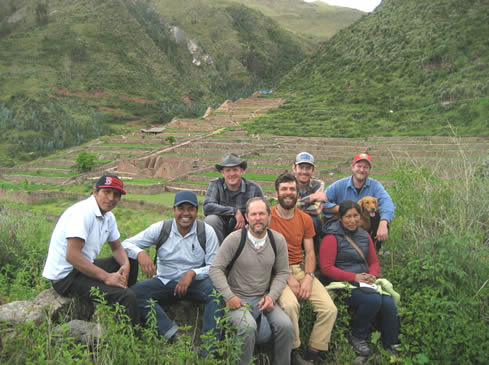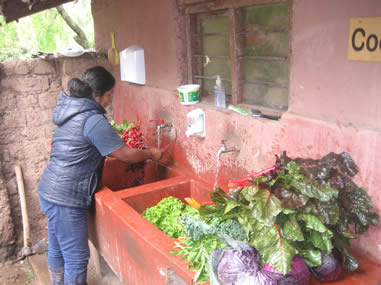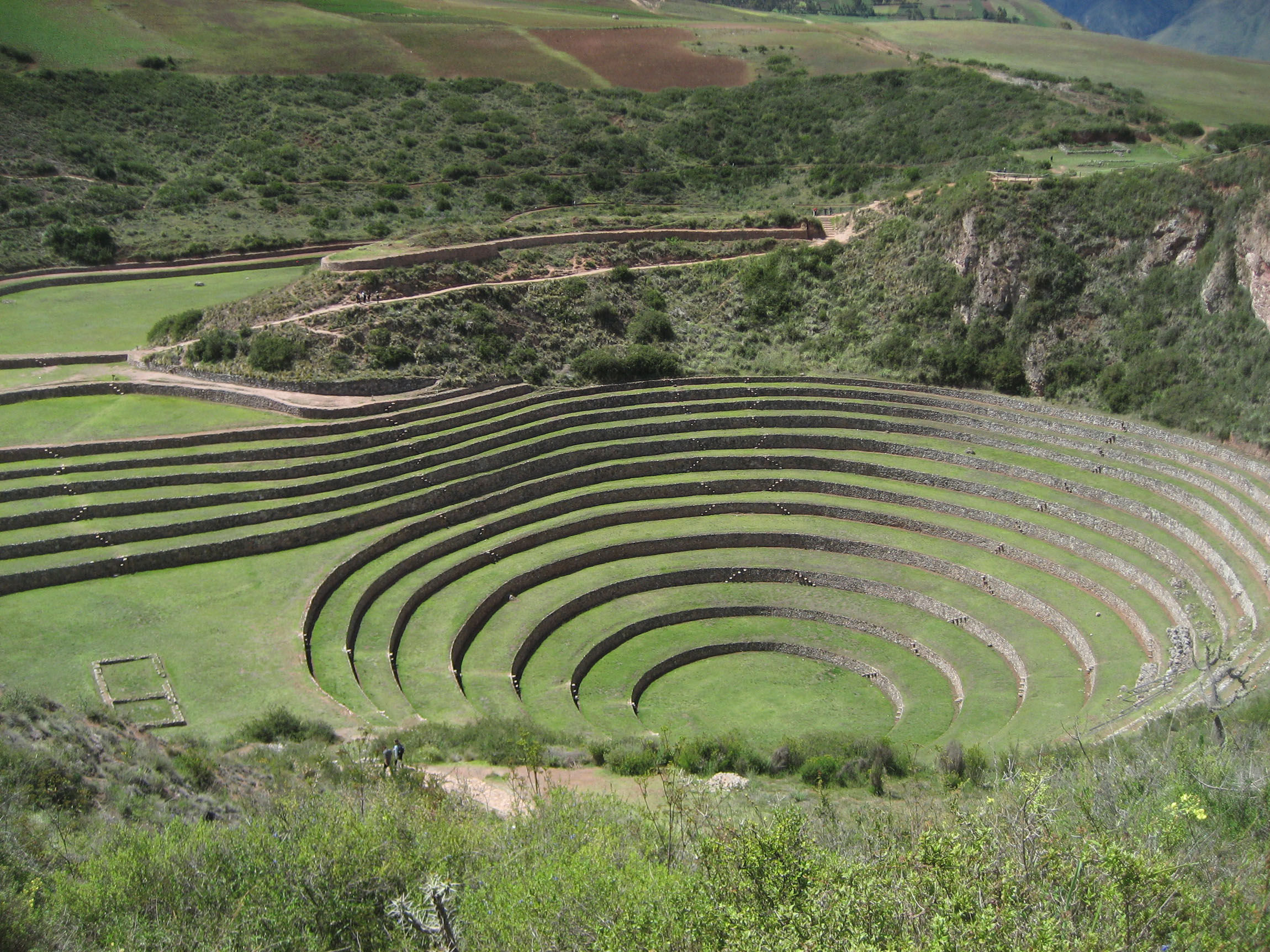A Reunion of Biointensive Farmers in the Sacred Valley of Peru
In January of 2019, a group of Ecology Action Farmer-Teachers took a 2–week trip to Peru to visit some of our friends in the larger Biointensive community and to explore the countryside in search of seed, soil and culture. The group included former Golden Rule Mini-Farm Field Coordinator (2012) Lucas Howerter; former The Jeavons Center Mini-Farm Manager (2011) Ryan Batjiaka; former The Jeavons Center Mini-Farm Manager (2013) Eric Buteyn; along with videographer Matt Anderson; Diego Fragoso Hernandez, former Victory Gardens for Peace Intern (2013) and Biointensive Farmer-Teacher from the Chinampas, Mexico City; and me. We visited some great Biointensive projects, hiked ancient trade routes to mystical ruins and were privileged to meet some wonderful Biointensive leaders who are keeping the movement growing south of the equator.
We spent almost all of our time in and around the Sacred Valley near Cusco, Peru. This special area was the cradle of the Inca, one of the more recent ancient civilizations to have left their mysterious and powerful footprint in the Andean Region of South America. Between warmhearted visits with our friends Julio Cesar Nina and Yessica Nina Cusiyupanqui, former Ecology Action Interns (2007 and 2005, respectively), their partners, the Andean Alliance for Sustainable Development, and community organizer Alain Dlugosz Salas, we squeezed in a few magnificent hikes to explore some of the terraces, temples, massive stone walls and impressive waterworks of the area. With a careful eye, you can find ruins around almost every river bend, over each ridge and nestled within the vast network of plains, valleys and peaks. Julio and Yessica's Mini-Farm, Eco-Huella (Green Footprint) in the small town of Calca, became our basecamp for the first half of the trip. They graciously hosted us and helped as we planned our travels. The evenings were full of laughter and delicious homegrown meals straight from the garden. Maize was served at every meal, toasted, steamed on the cob, or at other times roasted. The root vegetables were always delicious: sweet potatoes, potatoes and ulluco, a tuber similar to a potato but with a beet-like flavor. We spent hours talking about the challenges in the world that lie ahead and the work that needs to be done to bring the Biointensive method to more people.
One of the great challenges for campesinos is mirrored in many other indigenous cultures around the world. Decades of policies favoring resource extraction over conservation and human rights have made the livelihood of the campesino more difficult. The youth migrate to the cities, leaving an aging population to work the land and carry on the culture. These cultures are as precious as any—rich in tradition, bright in color, and intimately tied to the land. We were humbled to spend time with several wonderful campesinos who willingly shared their seeds and stories. In addition, climate change is having a major effect in these sensitive mountain regions. Despite the challenges, you can see the strength and joy in their faces. They truly are a humble and resilient people with a precious culture.
Staple crops such as maize and quinoa, luscious root crops like potatoes, ulluco, yacon, oca, mashua (edible nasturtium root) and tarwi (an edible lupine bean) were grown on the terraces and adapted to the conditions. As unique varieties became genetically stable and suited to the different microclimates within the terraces, they were then taken to specific growing regions throughout the Incan Empire. Sadly, the terraces are no longer used today. However, it isn't hard to imagine the people working the Earth, tending to the crops, and the great harvests that must have been celebrated in this special place. Most of the Sacred Valley is well above sea level, starting at 5,000'–8,000' with peaks above 10,000'–15,000'. It took several days to acclimate to the altitude, and just walking the streets in town required some careful breathing. Next, we visited Machu Picchu, a sacred site for the Incas. It is a place so beautiful that you can hardly believe what you're looking at. The architecture and elaborate system of drains and aqueducts baffle the mind, and the way the ruins are so perfectly situated on this peak leaves you speechless. It is so impeccably positioned at the confluence of rivers, surrounded by rings of lush and dramatic steep mountains. The place radiates serene, awe-inspiring beauty. After a night's rest in Calca, we hiked to the peak of a large mountain where we camped for the night. We met an old campesino who lived alongside a canal dug some 500 years ago by the Incans utilizing a spring located on the side of the mountain. He was quiet and had a wonderful sense of humor. His eyes, like those of so many other campesinos we met, were gentle and observant. Our next stop was to visit a fellow Biointensive farmer and seed saver in Tippon named Alain Dlugosz Salas. Alain is a friend of Diego's and a leader in the Latin American seed-saving network Red Semillas de Libertad (Free Seeds Network). An hour bus ride from Calca, and we were greeted warmly by Alain and his family. We were served warm cacao and fresh baked bread, and a delicious soup of roots and vegetables from the farm. There were bright and beautiful flowers everywhere. Alain carries a visionary spirit. Several years back he was guided to the town of Tippon by a dream. In this dream he was growing ancient plants out to seed in a ruin nestled within the hillside of the Sacred Valley. The ruins sat beneath a large peak, and his seeds became the foundation of a new community. The dream was powerful for Alain, and five months ago he and his family found the spot, purchased the land and began his great work. The name of Alain's project is Arariwakuna which is Quechuan for 'Watchmen'. In Quechuan culture the Arariwakunas guarded the chakras (small plots of land which are Biointensively farmed by the community) and the crops from animals and thieves. The chakras are still farmed today, though the tradition of the Arariwakuna has faded in the Sacred Valley. This tradition inspired Alain to name his project Arariwakuna. It was clear, as we walked through the community and greeted neighbors, that Alain takes his role seriously and with great love for his community.
Continue to page: 1 | 2
top | Newsletter Home |Table of Contents| Archive
|




 Julio and Yessica work in partnership with the Andean Alliance working with campesinos (Latin American farmers) to maintain their cultural heritage in challenging times of social and climate change. They help set up greenhouses and teach the Biointensive method with care and sensitivity. Their goal is to increase the sustainability of campesino villages by integrating the Biointensive method and economic mini-farming while promoting the exchange of traditional ideas and restoring dignity to the life of the campesino.
Julio and Yessica work in partnership with the Andean Alliance working with campesinos (Latin American farmers) to maintain their cultural heritage in challenging times of social and climate change. They help set up greenhouses and teach the Biointensive method with care and sensitivity. Their goal is to increase the sustainability of campesino villages by integrating the Biointensive method and economic mini-farming while promoting the exchange of traditional ideas and restoring dignity to the life of the campesino.  After a few days of settling in at Eco-Huella, we visited the ruins of Moray, where terraces that follow the valley contours served as agricultural research stations for developing and adapting the many unique crops to this region. It is said that as the sun moves across the horizon these terraces store heat and cold, and the convection of air and moisture creates microclimates which mimic a broad array of the microclimates found throughout the region.
After a few days of settling in at Eco-Huella, we visited the ruins of Moray, where terraces that follow the valley contours served as agricultural research stations for developing and adapting the many unique crops to this region. It is said that as the sun moves across the horizon these terraces store heat and cold, and the convection of air and moisture creates microclimates which mimic a broad array of the microclimates found throughout the region. 